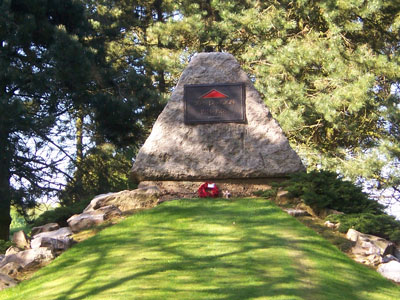
WWII: Maginot Line | Normandy | V-Weapon Sites | Arnhem
Further afield: Crete
| Home Tracing Military Ancestors Travel Advice CWGC Cemeteries Iron Harvest News Book Reviews Glossary Links Contact Me The Somme:
 
|
Location 4 – Newfoundland Memorial Park
Directions – Return to your car and proceed back down the road in the direction of Auchonvillers. Pass through the village on the D73 in the direction of Hamel. The Newfoundland Memorial Park is encountered on the left within a few minutes. A car park has recently been built opposite.
Practical Information – This is one of the most famous sites along the entire Western Front and expect coach-loads of school children and tourists for most of the day. However, to really experience the uniqueness of this place, which is one of a handful of locations where original trenches still exist on the British sectors of the Western Front, you may consider returning late in the afternoon when most of the coach parties have departed. On a recent trip in April 2009, I arrived at about 4:45pm to find the park practically deserted. There is an awful lot to see at this location, including a small museum charting the history of the Newfoundland Regiment and its part in the Battle of the Somme as well as memorials, cemeteries and the preserved trenches. It is worth allowing one and a half to two hours to see everything. On my first visit here in 1999 visitors were able to freely walk around the Park but increasing numbers have forced the Park authorities to guide visitors on a marked anti-clockwise route from the British frontline trenches in front of the Caribou Memorial down to "Y" Ravine and back again. I have followed this route for the photographs at the end of this section. Historical Notes – As with the 1st Lancashire Fusilier's attack further north in front of Beaumont Hamel, the Germans on this sector of front were also alerted by the blowing of the Hawthorn mine at 7:20am. Again they benefited from the British bombardment lifting at the same time. The result was equally as predictable. The assault battalions here consisted of the 2nd South Wales Borderers and 1st Borders of 87th Brigade, 29th Division. As they rose they were caught by fire from the trenches in front of the main German defensive feature, "Y Ravine", a disused quarry with deep dugouts driven into its leeward side which kept the defenders safe during the bombardment. The fire intensified as machine guns joined in from the German support trench directly behind "Y" Ravine and high up on the Beaucourt Ridge to their rear as well as artillery batteries, which pounded the British frontline trenches. The defenders' task was made easier by the fact that insufficient gaps had been cleared in the wire in front of the British trenches, forcing the assault troops to bunch in the handful of breaches. Within minutes the attack was effectively over and no-man's land lay strewn with the dead and dying. The act for which the Newfoundland Memorial Park is so named now unfolded. The reserve brigade of the division, the 88th, was ordered forward to try and get to grips with the enemy – a task which had already seen two fine battalions virtually wiped out. Amongst them was the 1st Newfoundland Regiment, raised entirely from volunteers of, what was at the time, a British colony, independent from Canada and the only colonial formation to take part in the first day of the battle. Owing to the dead and wounded of the earlier attacks blocking the forward and communications trenches, the brigade was forced to move above ground in full view of the enemy to reach the gaps in the British wire. By the time they got to where the entrance of the Memorial Park now is, men were falling. By the time they had reached half-way across no-man's land on the right of the Park near what is now called the "Danger Tree", there were only a handful still standing. Altogether the battalion lost 233 killed, with a further 386 wounded and 91 missing – 90% of the regiment had become casualties, one of the highest loss ratios for a unit on 1st July. The "Y" Ravine position was eventually captured by the 51st Highland Division in the great dawn attack of 13th November.
|
|||||||

